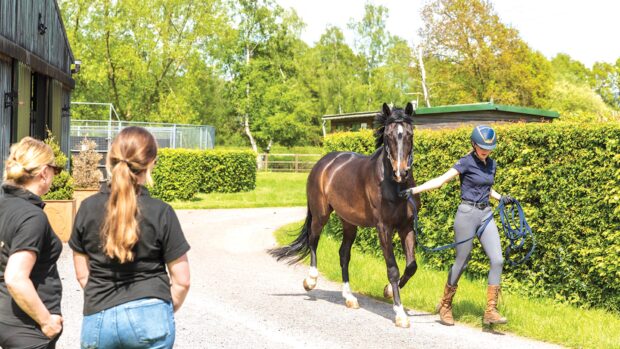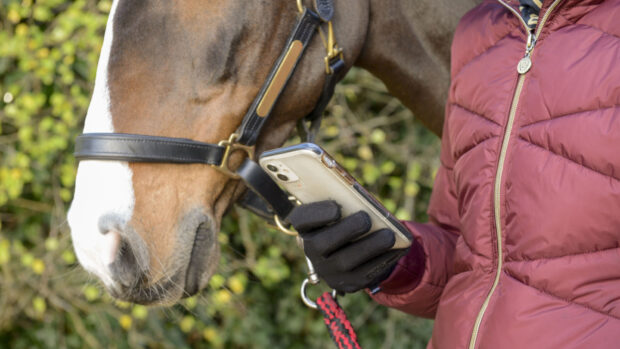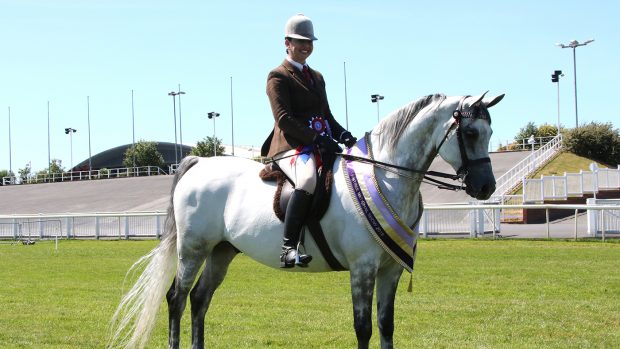If your child is hoping to jump in the show ring next season or they’re looking to move up a height section, then this guide on how to buy a working hunter pony is a good place to start.
What is a working hunter pony?
Working hunter classes are not only for adults on horses, but children and their ponies can also compete over a course of rustic fences. Working hunter classes are one of the most popular sections within showing.
Each class is split into two phases. The first phase awards 50 marks for jumping (marks deducted for faults) and 20 marks for style, while the second phase gives 10 for manners and way of going and a further 20 for conformation, type and freedom of action.
The combination with the highest final score wins the class.
There are different levels of working hunter pony classes, ranging from unaffiliated to national finals found at the two major showing championships, Horse of the Year Show (HOYS) and the Royal International (RIHS).
Most affiliated working hunter pony classes are run under rules set by the British Show Pony Society (BSPS). There are usually different height sections (see below) judged as separate classes, however some shows run mixed height classes, where each height of pony jumps a different sized course of fences before the combinations are judged as one class.
What height of working hunter does my child need?
There are age restrictions on each of the height classes, however it is common to find younger children riding larger heights of ponies due to the rates at which young people can grow.
Under BSPS rules, working hunter pony classes are divided into height sections:
- 133cm (Suitable to be ridden by a rider not to have attained their 14th birthday before 1 January in the current year)
- 143cm (Suitable to be ridden by a rider not to have attained their 17th birthday before 1 January in the current year)
- 153cm (Suitable to be ridden by a rider not to have attained their 20th birthday before 1 January in the current year)
- Exceeding 153cm or intermediate (horses exceeding 148cm but not exceeding 158cm, suitable to be ridden by a rider not to have attained their 25th birthday before 1 January in the current year)
The height of the fences depends on if you are jumping at novice, restricted or open level.
There are also two mini classes, cradle stakes (not exceeding 122cm. Riders not to have attained their 11th birthday before 1 January in the current year) and nursery stakes (not exceeding 133cm. Riders not to have attained their 12th birthday before 1 January in the current year.).
Other working hunter pony classes include tiny tots and working hunter teams competitions. One of the most challenging tests for working hunter ponies is the Desert Orchid championship held at the BSPS summer championships.
Native ponies have their own working hunter pony classes. Similarly, they jump in height but there are no age restrictions on M&M worker classes, aside from in junior or nursery/cradle classes.
What should I look for when buying a working hunter pony?
Working hunter ponies can vary in stamp and type. Often, a working hunter pony is an all-rounder that competes in other disciplines, or is a show hunter pony with a jump in it. A true working hunter pony should be able to fare in other spheres, such as on the hunt field.
Samantha (Sam) Darlington and her daughter Georgia Darlington have produced multiple top working hunter ponies. Georgia won the HOYS intermediate working hunter pony final in 2022 riding her own Jara. She was also champion M&M working hunter pony at HOYS in 2015 riding Welsh pony Tynwydd Good Friday. Georgia has also won the RIHS on each of the ponies. During her career Sam won HOYS and the RIHS over fences and she was also part of the England working hunter pony team.
“We always try to remember that a working hunter class is a showing class, so we’re looking for a type of animal that is good enough to show,” Sam says. “When we look at a pony and we ask ourselves if it would be good enough to show on the flat. For example, it must have correct conformation, move well and be straight.
“If I’m looking at a plaited pony then I would look at it as a show hunter pony. While it’s definitely harder to find these quality types today, once upon a time most riders would do both working hunter and show hunter classes with their ponies.
“If I were looking for a native, it would similarly need to be a conformationally correct animal that is of a good type and stamp for its breed. If a pony hasn’t jumped it can be hard to tell if it is going to make a worker. You could take a look at the breeding to gauge if it will jump, though it’s not a guarantee.
“If someone had come to me looking for a schoolmaster type for a child starting out, I would always encourage them to seek something slightly younger as it can be hard to know the exact background of a pony. A pony that has been trained correctly and has gained some experience in the ring but still needs bringing on in some way can still make a great learning pony and you can put your own stamp on it.
“Social media and online sources make it easier to find out a pony’s history, and if we have pursued a pony billed as a schoolmaster we make sure to do extensive homework before a viewing; we make sure that it has done what is being claimed. I would definitely not recommend buying a pony without going to view it. Many ponies can sound ideal on paper but when you look at their jumping record they’re not quite what it seems, as in they might be consistently having poles down, or might have issues with certain obstacles such as water trays.”
When assessing the ride of a working hunter pony, Georgia adds: “I like a worker to ride forward and pingy. I like something to take me to a fence as I don’t like kicking. I would want a prospect worker to be bold and careful over a fence.”
What about blemishes and injuries?
“A true blemish, caused by a knock or an accident, is passable if everything else is good,” says Sam. “I could overlook a splint or something similar if it didn’t impact soundness. A working hunter should have been jumped and hunted, so it’s unrealistic to expect their legs to be absolutely perfect.”
Where should I buy a working hunter from?
Working hunter ponies for sale will be advertised at various times in the season on online platforms, including with Horse & Hound, powered by Whickr. Often, top ponies with consistent CVs will be available after HOYS once the rider will be out of class for the next season.
Horses are often sold via word of mouth, as Sam explains: “It’s the best method in my opinion. Asking people who are out and about on the circuit and who have seen the pony around is the best way to gauge if it will do your job.”
How do I know if the pony is suitable?
Only you and your child will know if the pony you are viewing is the right one for you. Always consider if the experience of the rider matches up with the abilities and experience of the rider. Make sure you jump a pony on a viewing and if the seller will permit a trial period then you could pursue this, though not all sellers wish to let their ponies go out on trial.
How much should I pay for a working hunter pony?
Budget is hugely personal and it also depends on the time of year and the current market.
“It’s such a tricky question as it is dependent on so many different factors,” Sam says. “Every seller has a price in their mind, but a horse is only worth what someone is willing to pay. Some ponies go for less, some for more. However, an established pony in the current climate should be at least five figures, many well above.”
What happens when I’ve agreed to buy a working hunter?
When you have agreed on a sale, it is time to organise a pre-purchase vetting, something that is strongly recommended.
The vet will assess the horse with the specific job you want it for in mind, so it’s important to let the vet know prior to the vetting that your main goal is for a child to compete it as a working hunter.
If you tell the vet that you want the horse for the show ring, they should hopefully inform you of any blemishes or conformational faults which could impact its future career, even if they don’t impact its soundness or performance.
If the pony is for a child, then suitability and temperament should be taken into consideration by the vet.
Sam adds: “If you are spending a decent amount of money, I strongly recommend getting a vetting, ideally a five-stage vetting. An unbroken three-year-old could undergo a three-stage.”
For more information, you can read H&H’s ultimate guide to buying a horse.
- To stay up to date with all the breaking news from major shows throughout the year, subscribe to the Horse & Hound website
You may also be interested in:

Subscribe to Horse & Hound magazine today – and enjoy unlimited website access all year round

How can I buy the perfect working hunter?

Looking to buy a show hunter pony? Where to search and exactly what to look for

How can I make my own working hunter jumps at home?

How can I buy my perfect Connemara pony?




